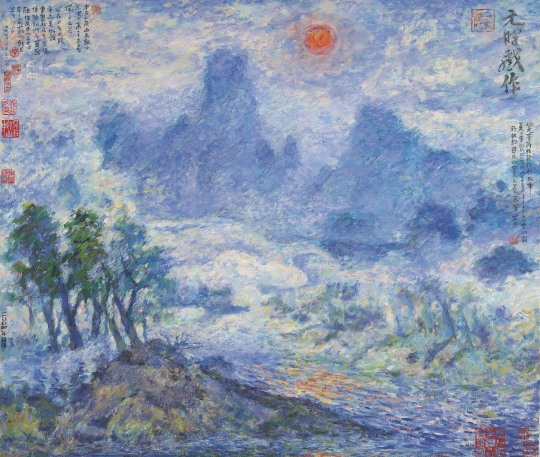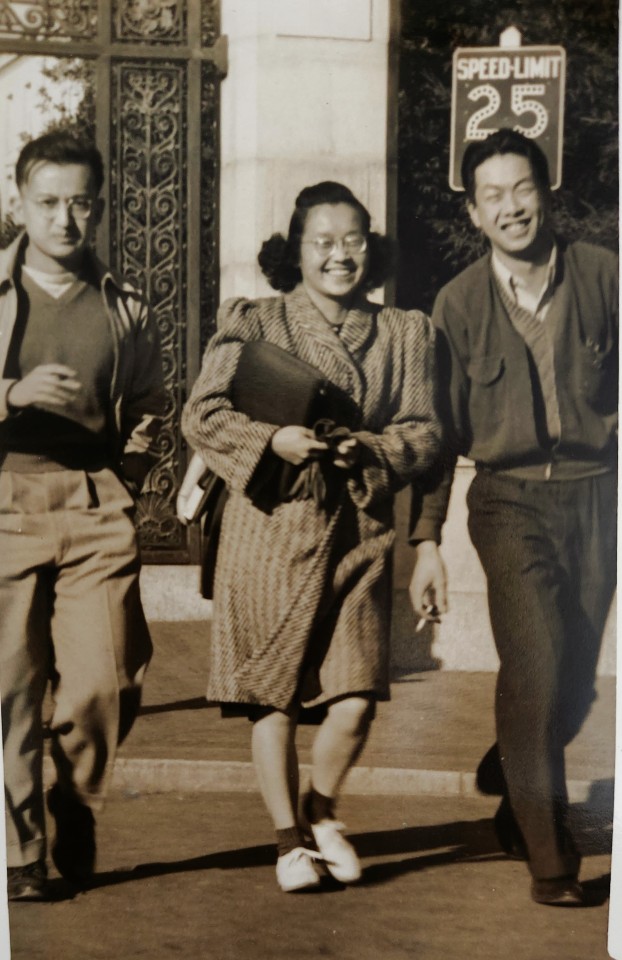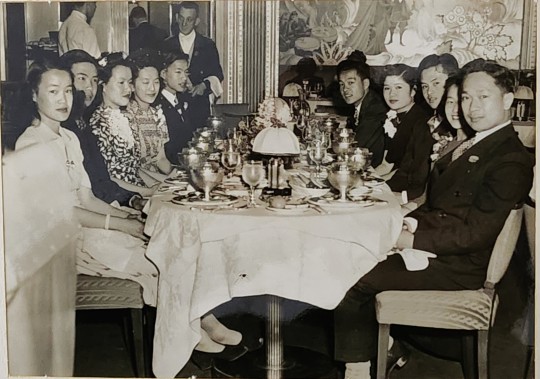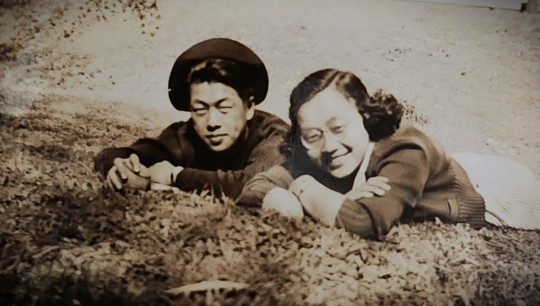#b. 1943 chinese
Explore tagged Tumblr posts
Text

Chen Huimin 陳慧敏 /b. 1943 chinese
24 notes
·
View notes
Text

Christmas Still Life - Moesey Li , 1996.
Chinese , b. 1943 -
Oil on canvas , 54. x 76 cm.
134 notes
·
View notes
Text

Zhang Hongtu (Chinese, b. 1943)
Mi Youren - Monet, 1999
oil on canvas
124 notes
·
View notes
Photo

Chen Huimin. Chinese, (b. 1943). Red Lotus.
5 notes
·
View notes
Text

(left to right) "Walter," Phyllis Soohoo, and Kenny Kai-Kee outside Sather Gate on the campus of the University of California Berkeley, c. 1940. Photographer unknown (from the collection of Doug Chan).
War and Mother's Remembrance
In an old photograph, a smiling Chinese coed strolls out of the University of California Berkeley’s Sather Gate, circa 1940. Observing this image, one cannot help but infer that my future mother didn’t lack for male companionship eight decades ago. However, beyond the personal anecdote, the photograph of the trio encapsulates a broader narrative about the adventurous spirit of Chinese American youth who began entering college in significant numbers on the cusp of the Second World War.
The Chinese students who enrolled at Cal in the late 1930’s represented a subset of the second or third generation offspring of the Chinese settlers in California. Despite being a minority, these students embodied the inaugural All-American generation of the Chinese diaspora in the US.

Chinese collegians dine at the Persian Room in the Sir Francis Drake Hotel, June 12, 1942. Hollywood Nite Club Photos (from the collection of Doug Chan). Phyllis Soohoo appears second from right.
The confluence of access to higher education and the backdrop of WWII proved to be a watershed moment for Chinese American youth. The war coincided with the formation and facilitated the ascent of the first Chinese American middle class.

UC Berkeley classmates Kenny Kai-Kee and Phyllis Soohoo at Lake Lagunitas, March 21, 1940. Photographer unknown (from the collection of Doug Chan).
With the outbreak of war, my mother took breaks to work for Shell Oil Co.'s laboratories, where she contributed to the development and testing of waterproofing treatments for equipment such as tents. Alongside other Chinese American men and women on the homefront, she undertook real jobs for the first time outside of the segregated Chinatowns. Her generation garnered newfound respect from their compatriots and the larger society amidst an era scarred by exclusion.
Time and the passing of her generation have dimmed the sacrifices made by many of my mother's contemporaries and, most poignantly, the memories of young men who had served and fallen in combat.
Kenny Kai-Kee was the classmate and a friend seen at the right in my mother's photograph outside of Sather Gate. Remembered as a jovial and talented athlete who secured a spot on Cal's varsity basketball team, Kenny would earn a lieutenant's commission, joining the US Army Air Force in October 1943 and qualifying as a bomber pilot. As recounted in my earlier writing here, this year marks the 80th anniversary of the downing of Kenny’s B-17 to enemy fire over Austria in late July 1944.

Lt. Kenneth Kai-Kee poses in his US Army Air Force uniform before shipping out for service with the US Army Air Force in Europe, October 1943. Photographer unknown (from the collection of Phyllis Soohoo Chan).
My mother was a compulsive archivist. She kept all of the half-dozen photos of her and her former boyfriend, Kenny. She would continue to refer to grief-stricken parents, Lock and Rita, as “Mom” and “Pop,” and send them a Christmas card every year after that terrible summer of 1944. Years later, when her own family went out for dinner in Oakland, she would meet and greet Kenny’s parents on the sidewalks of Chinatown as the old-time families usually encountered each other going to or from dinners at the old Silver Dragon.
Kenny’s remains had been interred initially in a distant plot. The German records recorded a burial first on July 27, 1944, in the cemetery of St. Jakob i. Walde, Austria. More than five years later, Lock and Rita were notified that Kenny’s remains were coming “home” to be re-interred at the Jefferson National Cemetery Barracks. His parents traveled back to St. Louis, Missouri, to witness the re-interment, which occurred on May 15, 1950.
In a letter to my future mother, dated June 12, 1950, Rita wrote as follows:
“Dear Phyllis, "Please accept a very belated ‘Thanks’ for the cute Mother’s Day card and the kind thoughts conveyed. I was not at home on that day. Lock and I arrived in St. Louis, Mo. on the afternoon of Mother’s day. “I don’t know whether you have heard that Kenneth’s remains were found, together with those of two other boys. Inasmuch as each could not be individually identified the government had them brought back in a group for burial at a national cemetery. St. Louis was chosen as it was the most centrally located for the three families involved. The military services which took place on May 16th were very simple and very nice. … * * * “You young people who were Kenneth’s friends ae always so close to me that I almost feel you are my family. … “Anytime you are around this neighborhood drop in on us. We are always glad to see you. “Thanks again and again. “Love, “’Mom’ Kai-Kee”
No one can recall if Lock and Rita Kai-Kee ever revisited their son’s lonely grave in St. Louis, so far from family, friends and loved ones. If my mother knew of the location of Kenny’s grave when a cross-country motor trip with her family drove her through St. Louis in the summer of 1964, she never mentioned it. On the two or three times when I had asked her about Kenny, I recall her fleeting, faraway look when she mentioned his name. She and millions of other Americans knew first-hand not only the young men who had never returned from the great global conflagration of the 1940s, but the loss, grief, and the devastation of war. Like many other Americans who were left behind in sorrow, my mother emerged from the war years with not only her pharmacist's license but also specific, painful reasons to detest the horrors of the global conflict and its waste of life.
Another decade would pass before Mom crossed paths with my father. He had shared none of the transformational experiences of my mother's college cohort. His family had struggled during the years of the Great Depression in San Francisco Chinatown, and he lacked the means, and perhaps the inclination, to pursue university education before enlisting in the US Coast Guard.
Rita Kai-Kee would carry the bitterness of Kenny's loss and the cruelty of war’s cost until her death in August 1983. Lock died seven months later.
After my mother's passing in 2001, my then-grieving father had dispassionately set all of her personal effects, records, and old photos for disposal. I reclaimed a portion of her captured memories from a grim jumble of items he had discarded for the dump. Among the carefully compiled sets of letters and photos about her side of the family, were the small snapshots of her with Kenny and his portrait in uniform. My mother’s archive provided glimpses into a personal life in which Dad had played no part, separated by a ferry ride and later a new Bay Bridge. As such, her mementos comprised a sentimental narrative, ending on the eve of her encountering my father in San Francisco Chinatown’s Powell Garage in 1953.
I was brought into the world about a year later. Decades later, I would find among a pile of baby gift cards from family and friends the small card sent to my mother by “Mom” and “Pop” Kai-Kee. My mother had included their names on my birth announcement list.


The loss of Kenny Kai-Kee, the only son of a pioneering family, was doubly bitter because he exemplified the first All-American generation of Chinese. Death deprived him of the realization that the Second World War proved to be a watershed event for Chinese American youth. The young men and boys who flew in the B-17s of the 8th and 15th Air Forces came home to a Chinese America not quite free of the strictures of white racism, but well on its way to equal rights for Chinese Americans, freed from the Chinese Exclusion Act.
The war coincided with the making, and spurred the rise, of the first Chinese American middle class. As the image and condition of the Chinese in America changed, so did its economic opportunities. By 1943 -- the year the Exclusion Act was repealed -- 15 percent of the shipyard workers on San Francisco Bay were Chinese. During the war, Chinese American men and women were working real jobs for the first time in the world’s only industrial behemoth and gaining new respect from their fellow citizens.
Had he returned to Oakland, Kenny would have heard the laughter of unprecedented numbers of children in the Nation’s Chinatowns. He would have seen his buddies buying houses in gradually desegregating neighborhoods, resuming college careers on the G.I. Bill, and wading into the social and cultural mainstream of postwar America.
We will never know what Kenny could have accomplished had he lived. He probably would have married his fiancee Alice, the love of his short life, raised a family and grown old. We would have met and seen him as just another 80-year-old senior citizen, serving up decades' worth of easy banter along with the stacks of pancakes at the Wa Sung Club’s annual Easter breakfast. As a member of one of Chinese America’s greatest generations, he would have made his own contribution to community after his years serving the country.
Instead, we are left only with the perplexing example of the wrenching deaths of Kenny and the thousands of other young men who never made it back home. Such selflessness demands that we ponder the meaning of his brief life and how in our time, beyond the words and through our own deeds, we as Americans can make his death meaningful and us worthy of such a sacrifice.
If each generation must renew the task of reclaiming Chinese American history, then the stories of both gallantry and sacrifice should be told again and again. With each retelling, a new generation — both native-born and immigrant — is called to an act of faith in the future, reaffirming the hope that the mere utterance of the names will preserve the memories of their lives, valor, and sacrifices of the Chinese Americans who marched, sailed or flew in harm’s way. This solemn duty falls to ethnic historians and storytellers to remember the community’s forgotten heroes in unforgettable ways.
[2024-9-25]
2 notes
·
View notes
Text



𝑶𝑭 𝑻𝑬𝑹𝑹𝑰𝑩𝑳𝑬 𝑪𝑶𝑵𝑭𝑬𝑺𝑺𝑰𝑶𝑵𝑺 ...
𝘪𝘵'𝘴 𝘵𝘢𝘬𝘦𝘯 𝘮𝘦 𝘴𝘰 𝘧𝘢𝘳 𝘣𝘦𝘺𝘰𝘯𝘥 𝘵𝘩𝘦 𝘱𝘰𝘪𝘯𝘵 𝘰𝘧 𝘯𝘰 𝘳𝘦𝘵𝘶𝘳𝘯
𝐓 𝐇 𝐄 𝐄 𝐗 𝐓 𝐑 �� . . .
name ( s ) : viktor drake ( undisclosed government name ) . alias : viktor drake , vik , viky ( careful with that one ) . d . o . b . december 4 , 1943 . in : san francisco , california . he holds citizenship in the united states of america . he speaks : english , moreno version of italian . religious beliefs : raised by non-practicing roman catholics — returned upon moreno family undercover op . educational achievements : bachelors degree in criminal justice . current occupation : underboss for the moreno family . former occupation : fbi agent until '78 . eye colour : dark brown . hair colour : black varies from shoulder length to shorter , namely shorter in the 70's and 80's . height : 6′1″ , 186 cm . distinguishing characteristic : aroma of tobacco lingering , catholic crucifix tattoo between his shoulder blades with latin writing .
current theory : possible waning confidence on the state of the moreno's after lev's death . frequent locations : the halcyon , hotel calgarie when necessary , the one chinese restaurant off fifth ave . habits : spending holidays alone at restaurants , smoking excessively . prized possession : engraved zippo lighter gifted to him by the late lev ' lucky ' moreno .
inspo ; 𝘥𝘰𝘯𝘯𝘪𝘦 𝘣𝘳𝘢𝘴𝘤𝘰 ( 1997 ) , 𝘫𝘢𝘮𝘦𝘴 𝘭𝘰𝘨𝘢𝘯 𝘩𝘰𝘸𝘭𝘦𝘵𝘵 ( 𝘹-𝘮𝘦𝘯 ) , 𝘫𝘰𝘩𝘯𝘯𝘺 𝘶𝘵𝘢𝘩 ( 𝘱𝘰𝘪𝘯𝘵 𝘣𝘳𝘦𝘢𝘬 ) , 𝘰𝘯𝘦 𝘰𝘧 𝘵𝘩𝘦 𝘮𝘢𝘯𝘺 𝘷𝘢𝘳𝘪𝘢𝘵𝘪𝘰𝘯𝘴 𝘰𝘧 𝘣𝘳𝘶𝘤𝘦 𝘸𝘢𝘺𝘯𝘦'𝘴 𝘤𝘩𝘢𝘳𝘢𝘤𝘵𝘦𝘳
𝐓 𝐇 𝐄 𝐒 𝐓 𝐎 𝐑 𝐘 . . .
the day one is born, one is nearly taken. a life for a life, living on borrowed time and death comes like a debt collector one cold december night. a place he hasn't been, but new york whispers its promises, where twinkling lights illuminate the city and the rush of the metro past the vacant platform tightens a boy's grip on his mother's hand. darkness never shrouds them but the light flickering overhead gives way to the cold barrel of a gun pointing at her, the woman whose hand he holds. and it's always the same; the pearls around her neck, the purse over her shoulder. . . 𝘵𝘩𝘦 𝘥𝘪𝘢𝘮𝘰𝘯𝘥 𝘰𝘯 𝘩𝘦𝘳 𝘧𝘪𝘯𝘨𝘦𝘳, and because of this she must let go. and upon returning, san francisco is colder somehow, the fog is heavier and the cherry red cable cars rolling up and down familiar streets remain his only constant. his father sits in the corner of the living room with silent regret louder than words can ever be. he should have gone with them. and she's still there too, his mother, in debt to death more than most, but left with a reminder. 𝘧𝘰𝘳𝘦𝘷𝘦𝘳 𝘢𝘭𝘵𝘦𝘳𝘦𝘥. and that reminder is a push of fate, his fate. next to his father's morning coffee, the newspaper headlining the fbi's most wanted and a mugshot searing into his memory, one of them. 𝘵𝘩𝘪𝘴 𝘪𝘴 𝘩𝘪𝘴 𝘳𝘦𝘷𝘦𝘯𝘨𝘦 𝘴𝘵𝘰𝘳𝘺. his twenties are serviced to a double life. a throw away special agent, one foot in and one out. he's expendable enough, but he's ' got what it takes ' they tell him. he's the one who can end it all. and he thinks so too. pompous might and the expense of youth, the fbi craves it. but so does another. at the hands of a fresh faced attorney he finds his way in. she is the first to bind him, and soon wire tapped conversations and acceptance from crooks feels a little less like a means to an fbi weekly check in. mannerisms cannot be turned off, speech patterns bleed into outside conversations, and relationships. . . 𝘪𝘵'𝘴 𝘸𝘩𝘦𝘳𝘦 𝘵𝘩𝘦 𝘭𝘪𝘯𝘦𝘴 𝘣𝘭𝘶𝘳. years in. he marries, for his cover. he fathers children, for his cover. he kills, for his cover and he's disowned, for his cover. . . 𝘣𝘦𝘤𝘢𝘶𝘴𝘦 𝘪𝘵'𝘴 𝘯𝘰𝘵 𝘢 𝘤𝘰𝘷𝘦𝘳 𝘢𝘯𝘺𝘮𝘰𝘳𝘦. and lev moreno knows this, it's a waiting game. a test and viktor makes his decision the day he blows the fbi's sting operation. his pledge of allegiance, but his penance is serving at the bottom, until again, he makes a sacrifice at the alter of lev moreno. his blood ties are chosen and it's all he has left. 𝘵𝘩𝘦 𝘰𝘯𝘭𝘺 𝘸𝘢𝘺 𝘵𝘩𝘳𝘰𝘶𝘨𝘩 𝘪𝘴 𝘧𝘰𝘳𝘸𝘢𝘳𝘥. the climb to the top is not without sacrifice, and when he can give no more he finds the title he's come to earn to be no less a personal hell than the one he's paid for since the day he chose.
𝐓 𝐇 𝐄 𝐂 𝐎 𝐍 𝐍 𝐄 𝐂 𝐓 𝐈 𝐎 𝐍 𝐒 . . .
the agent , the partner he had when part of the fbi in the '70s, the one that he checked in with during his undercover op who he blindsided after turning on the fbi for the moreno family
the ex wife ( 𝘵𝘢𝘬𝘦𝘯 𝘣𝘺 𝘥𝘦𝘭𝘪𝘭𝘢𝘩 𝘤𝘢𝘯𝘯𝘰𝘯 ) , she was his initial ' in ' with the moreno family back in the 70's and the mother of his child, divorcing in '81.
trust issues , neither seem to be too fond of each other, reasons neither can seem to articulate. call it a hunch, a feeling. in the moreno group and would not be aware, like most are not of the fbi past
keeping the bed warm , it's as heartless as it sounds, and both know it.
( 𝘮𝘢𝘯𝘺 𝘮𝘰𝘳𝘦 𝘵𝘰 𝘤𝘰𝘮𝘦 𝘪 𝘫𝘶𝘴𝘵 𝘤𝘢𝘯𝘯𝘰𝘵 𝘵𝘩𝘪𝘯𝘬 𝘳𝘪𝘨𝘩𝘵 𝘯𝘰𝘸 )
2 notes
·
View notes
Text
Events 1.18 (before 1970)
474 – Seven-year-old Leo II succeeds his maternal grandfather Leo I as Byzantine emperor. He dies ten months later. 532 – Nika riots in Constantinople fail. 1126 – Emperor Huizong abdicates the Chinese throne in favour of his son Emperor Qinzong. 1486 – King Henry VII of England marries Elizabeth of York, daughter of Edward IV, uniting the House of Lancaster and the House of York. 1562 – Pope Pius IV reopens the Council of Trent for its third and final session. 1586 – The magnitude 7.9 Tenshō earthquake strikes Honshu, Japan, killing 8,000 people and triggering a tsunami. 1670 – Henry Morgan captures Panama. 1701 – Frederick I crowns himself King in Prussia in Königsberg. 1778 – James Cook is the first known European to discover the Hawaiian Islands, which he names the "Sandwich Islands". 1788 – The first elements of the First Fleet carrying 736 convicts from Great Britain to Australia arrive at Botany Bay. 1806 – Jan Willem Janssens surrenders the Dutch Cape Colony to the British. 1866 – Wesley College is established in Melbourne, Australia. 1871 – Wilhelm I of Germany is proclaimed Kaiser Wilhelm in the Hall of Mirrors of the Palace of Versailles (France) towards the end of the Franco-Prussian War. Wilhelm already had the title of German Emperor since the constitution of 1 January 1871, but he had hesitated to accept the title. 1886 – Modern field hockey is born with the formation of The Hockey Association in England. 1896 – An X-ray generating machine is exhibited for the first time by H. L. Smith. 1911 – Eugene B. Ely lands on the deck of the USS Pennsylvania anchored in San Francisco Bay, the first time an aircraft landed on a ship. 1913 – First Balkan War: A Greek flotilla defeats the Ottoman Navy in the Naval Battle of Lemnos, securing the islands of the Northern Aegean Sea for Greece. 1915 – Japan issues the "Twenty-One Demands" to the Republic of China in a bid to increase its power in East Asia. 1919 – World War I: The Paris Peace Conference opens in Versailles, France. 1919 – Ignacy Jan Paderewski becomes Prime Minister of the newly independent Poland. 1941 – World War II: British troops launch a general counter-offensive against Italian East Africa. 1943 – Warsaw Ghetto Uprising: The first uprising of Jews in the Warsaw Ghetto. 1945 – World War II: Liberation of Kraków, Poland by the Red Army. 1958 – Willie O'Ree, the first Black Canadian National Hockey League player, makes his NHL debut with the Boston Bruins. 1960 – Capital Airlines Flight 20 crashes into a farm in Charles City County, Virginia, killing all 50 aboard, the third fatal Capital Airlines crash in as many years. 1967 – Albert DeSalvo, the "Boston Strangler", is convicted of numerous crimes and is sentenced to life imprisonment. 1969 – United Airlines Flight 266 crashes into Santa Monica Bay killing all 32 passengers and six crew members.
1 note
·
View note
Photo
張宏圖 Chinese (b. 1943)

Zhang Hongtu
4K notes
·
View notes
Text

Master Sergeant William Jones (July 15, 1918 - December 3, 2009) one of the last Buffalo Soldiers, was an Army Master Sergeant, Prisoner of War in Korea, and successful entrepreneur. He was born in Tamo, Arkansas to farmers Joseph and Elizabeth Jones, the youngest of seven children.
He grew up in Kansas and attended the “colored school” in Coffeyville, Kansas. On March 5, 1941, he enlisted in the Army at Fort Leavenworth. He was assigned to the 10th Calvary in Fort Riley, becoming part of the last generation of buffalo soldiers.
In 1943, the 9th and 10th Calvary were integrated into the Army Air Corps with the mission of building airstrips in North Africa and Italy for B-17 bombers. Beginning in March 1944, He was assigned to Casablanca, Morocco, and later Naples, Italy.
He was deployed to Manila, where he built airstrips for B-17 bombers to fly deep strikes into Japan. Before his unit became fully operational, atomic bombs were dropped on Hiroshima and Nagasaki, Japan ending WWII.
He was assigned to Fort Lawton and his all-Black unit was designated the 503rd Field Artillery with the 2nd Infantry Division. The unit deployed to Pusan, Korea on August 3, 1950, after the start of the Korean conflict. They were overrun by Communist Chinese forces and he was captured and held in the Pyok-Dong POW camp. For three years he survived horrendous conditions that saw eight to ten captives die each night. He was released on September 5, 1953, at the end of the Conflict, and returned to Tacoma as a hero.
He was assigned to the 546th Field Artillery Battalion at Fort Lewis. After 20 years of military service, he retired as a Master Sergeant in El Paso. He was a truck driver, artillery mechanic, supply clerk, and marksman/ sharpshooter.
He started a thriving recycling and vintage antique business in Tacoma. To keep the memory of pioneering Black soldiers alive, he opened the Ninth and Tenth (Horse) Cavalry Museum in Tacoma.
He lived in Tacoma for 55 years, with his wife Hannah, who died in 1972. He was survived by his four children. #africanhistory365 #africanexcellence
1 note
·
View note
Text
On this day in Wikipedia: Friday, 29th March
Welcome, vitajte, ongi etorri, ողջու՜յն (voġčuyn) 🤗 What does @Wikipedia say about 29th March through the years 🏛️📜🗓️?

29th March 2023 🗓️ : Death - Vivan Sundaram Vivan Sundaram, Indian contemporary artist (b. 1943) "Vivan Sundaram (28 May 1943 – 29 March 2023) was an Indian contemporary artist. He worked in many different medias, including painting, sculpture, printmaking, photography, installation, and video art, and his work was politically conscious and highly intertextual in nature. His work constantly..."

Image licensed under CC BY 3.0? by George Quasha
29th March 2019 🗓️ : Death - Agnès Varda Agnès Varda, French film director (b. 1928) "Agnès Varda (French: [aɲɛs vaʁda] ; born Arlette Varda; 30 May 1928 – 29 March 2019) was a Belgian-born film director, screenwriter, photographer, and artist with French and Greek origins. Varda's work employed location shooting in an era when the limitations of sound technology made it easier and..."

Image by Unknown authorUnknown author
29th March 2014 🗓️ : Event - Same-sex marriage in the United Kingdom The first same-sex marriages in England and Wales took place following the passage of the Marriage (Same Sex Couples) Act 2013. "Same-sex marriage is legal in all parts of the United Kingdom. As marriage is a devolved legislative matter, different parts of the United Kingdom legalised at different times; it has been recognised and performed in England and Wales since March 2014, in Scotland since December 2014, and in..."
29th March 1974 🗓️ : Event - Shaanxi A group of farmers in the Chinese province of Shaanxi discovered a vast collection of terracotta statues (pictured) depicting the armies of Qin Shi Huang, the first emperor of China. "Shaanxi is a landlocked province of China. Officially part of Northwest China, it borders the province-level divisions of Shanxi (NE, E), Henan (E), Hubei (SE), Chongqing (S), Sichuan (SW), Gansu (W), Ningxia (NW) and Inner Mongolia (N). Shaanxi covers an area of over 205,000 km2 (79,151 sq mi) with..."

Image licensed under CC BY-SA 4.0? by N509FZ
29th March 1924 🗓️ : Death - Charles Villiers Stanford Charles Villiers Stanford, Irish composer and conductor (b. 1852) "Sir Charles Villiers Stanford (30 September 1852 – 29 March 1924) was an Anglo-Irish composer, music teacher, and conductor of the late Romantic era. Born to a well-off and highly musical family in Dublin, Stanford was educated at the University of Cambridge before studying music in Leipzig and..."

Image by Bassano Ltd
29th March 1824 🗓️ : Birth - Ludwig Büchner Ludwig Büchner, German physiologist, physician, and philosopher (d. 1899) "Friedrich Karl Christian Ludwig Büchner (29 March 1824 – 30 April 1899) was a German philosopher, physiologist and physician who became one of the exponents of 19th-century scientific materialism...."

Image by Unknown authorUnknown author
29th March 🗓️ : Holiday - Boganda Day (Central African Republic) "This is a list of public holidays in the Central African Republic..."
0 notes
Text
History
November 22, 1497 - Portuguese navigator Vasco Da Gama, leading a fleet of four ships, became the first to sail round the Cape of Good Hope, while searching for a sea route to India.
November 22, 1718 - Blackbeard the pirate (Edward Teach) was killed off the coast of North Carolina after a long and prosperous career. Lt. Govenor Alexander Spotswood of Virginia had sent two sloops to put an end to him. The sailors encountered Blackbeard and Lt. Robert Maynard killed him in the fight that followed.
November 22, 1935 - Trans-Pacific airmail service began as the China Clipper, a Pan American flying boat, took off from San Francisco, reaching the Philippines 59 hours later. The following year, commercial passenger service began.
November 22, 1943 - The Cairo Conference occurred as President Franklin D. Roosevelt, British Prime Minister Winston Churchill, and Chinese Nationalist leader Chiang Kai-shek, met to discuss the war in the Pacific against Japan.
November 22, 1963 - At 12:30 p.m., on Elm Street in downtown Dallas, President John F. Kennedy's motorcade slowly approached a triple underpass. Shots rang out. The President was struck in the back, then in the head. He was rushed to Parkland Memorial Hospital where fifteen doctors tried to save him. At 1 p.m., John Fitzgerald Kennedy, 35th President of the United States, was pronounced dead. On board Air Force One, at 2:38 p.m., Lyndon B. Johnson was sworn in as the 36th President.
November 22, 1975 - Juan Carlos was sworn in as King of Spain, following the death of General Franscisco Franco who had ruled as dictator since 1939.
November 22, 1990 - British Prime Minister Margaret Thatcher announced she would resign after 11 years in office, the longest term of any British Prime Minister in the 20th century.
Birthday - Charles De Gaulle (1890-1970) was born in Lille, France. He led the Free French against the Nazis during World War II and later became President of France, serving from 1958-69.
Birthday - Barnstorming aviator Wiley Post (1898-1935) was born in Grand Plain, Texas. He was a self-taught pilot who became an international celebrity in the 1930s and co-authored Around the World in Eight Days. In 1935, Post and his friend Will Rogers began a flight to the Orient, however, the plane crashed near Point Barrow, Alaska, killing both of them.
Birthday - British composer Benjamin Britten (1913-1976) was born in Lowestoft, Suffolk, England. Best known for his operas including Peter Grimes and his choral works A Ceremony of Carols and War Requiem.
0 notes
Text

楊明義 Yang Mingyi (Chinese, b. 1943)
A Hundred Bridges
23 notes
·
View notes
Text

"Frank B. Lee, 24, who has won three scholarships at Queen's University. He took the University Scholarship of $100, the Association of Professional Engineers Scholarship, $75, and the Andrina McCulloch Public Speaking Scholarship, $45. He also won three scholarships during his first year. Before entering Queen's he was employed by the Post Office Department. His brother, Bing Shuey Lee, is first secretary of the Chinese legation. - Photo by Horsdal." - from the Ottawa Citizen. May 25, 1943. Page 1.
#ottawa#chinese legation#kingston ontario#scholarship winner#scholarship#engineering student#queen's university#canada during world war 2#chinese canadians#chinese immigration to canada#university student
0 notes
Text
Shang Chi and the Legend of Ten Rings Shows How Far We’ve Come and the Progress We Still Have to Make

I have a confession to make: I’ve never seen a Marvel movie. I have found the garish overuse of CGI too distracting in the trailers, so I’ve always strayed away and stuck with action movies that emphasize practical effects (e.g., the Mission: Impossible and John Wick franchises). But Shang-Chi and the Legend of Ten Rings piqued my interest because of the fantastic cast (Simu Liu! Awkwafina! Michelle Yeoh!), and I knew I wanted to write about it for this class. Although I found the computer-generated special effects distracting, I thought the story, with themes regarding identity and family, was excellently told by a cast that has long broken barriers in Hollywood.
Shang-Chi and the Legend of Ten Rings follows Shang-Chi (Simu Liu) as he is beckoned back home to China to confront the mysterious Ten Rings organization and wrestle with his family’s complicated dynamics. In the beginning of the movie, there are themes of immigration, with Shang-Chi anglicizing his name to Shaun when moving to the United States. This mirrors Liu’s real-life journey, as he was born in China and immigrated to Canada at five-years-old. In 2021, Liu wrote a guest column in Variety talking about his families’ encounters with racism. This is further reflected in A Different Mirror, where Ronald Takaki explains the history of racism experienced by Asian immigrants in the US. The Chinese Exclusion Act passed in the United States in 1882 further propelled this racism, where then-President Rutherford Hayes explained his reasoning for the act by stating “the present Chinese invasion…[is] pernicious and should be discouraged.” In 1943, this act that had been rooted in racism was finally repealed.
Liu’s experiences with racism after immigrating to the United States are telling that progress is not yet done. However, Liu himself is helping break barriers, being the lead in the first Marvel movie with a predominantly Asian cast. Other cast members, including Awkwafina and Michelle Yeoh, have also broken barriers: Awkwafina was the first actress of Asian-American descent to win a Golden Globe in the Best Musical or Comedy Category (for Lead Actress of The Farewell) while Michelle Yeoh was the first actress of Asian descent to win an Academy Award for Best Actress (for Everything Everywhere All at Once).
youtube
A skit from Simu Liu’s episode hosting SNL where he and cast member Bown Yang compete over being the “First Asian” to do things such as “First Asian Man to Deadpan on Splash Mountain.”
One particular stand-out scene in Shang-Chi is the bus fight that mirrors the iconic action movie Speed and is similar in style to the films of Jackie Chan, who is one of the most recognizable Asian actors in the world. Furthermore, the bus fight scene is soundtracked by DJ Snake, whose music video for “Turn Down for What” featured a predominantly Asian cast, which was “revolutionary in its day”...which was 2014. Since then, progress in representation has been made.
youtube
The bus fight in Shang-Chi, which mirrors action movie Speed (1994), which stars Keanu Reeves, who is of Chinese-Hawaiian descent on his father’s side.
It is clear that Shang-Chi and the Legend of Ten Rings was an important stepping stone for representation in both movies and Marvel. Since the release of Crazy Rich Asians in 2018, there have been more movies featuring predominantly Asian casts, including Everything Everywhere All at Once (2022) and Joy Ride (2023). However, the magic of the movie theater cannot fix everything, and Anti-Asian racism still unfortunately exists in the United States. Liu offers up a solution, explaining “Anti-Asian racism is very real, and it will not be solved with an opulent rom-com or Marvel superhero, but with you — the bystanders — acknowledging the validity of our pain.” Just as Shang-Chi does in the movie, we must acknowledge our painful past, realize our mistakes, and embrace the best version of ourselves in order to move forward and forge a better future for everyone.
Works Cited (listed alphabetically)
Vanessa Etienne, “Keanu Reeves on His 'Love' for His Asian Background, the 'Respectful' Way 'Matrix' Includes Culture,” People, December 21, 2021, https://people.com/movies/keanu-reeves-talks-love-for-his-asian-identity-admits-mixed-feelings-being-called-person-of-color/.
"Shang-Chi and the Legend of Ten Rings Soundtrack," Tunefind, September 3, 2021, https://www.tunefind.com/movie/shang-chi-and-the-legend-of-the-ten-rings-2021.
Simu Liu, “‘Shang-Chi’ Star Simu Liu: ‘Anti-Asian Racism Is Very Real’ (Guest Column),” Variety, March 11, 2021, https://variety.com/2021/film/news/shang-chi-simu-liu-anti-asian-racism-1234928348/.
Ronald Takaki, A Different Mirror (New York: Back Bay Books, 2008), 189.
Glen Weldon, “Michelle Yeoh is the First Asian woman to win best actress Oscar,” NPR, March 13, 2023, https://www.npr.org/2023/03/12/1158764789/michelle-yeoh-best-actress-oscar-everything-everywhere-all-at-once#:~:text=Michelle%20Yeoh%20makes%20Oscar%20history%20with%20best%20actress%20win%20The,Everything%20Everywhere%20All%20at%20Once.
Alissa Wilkinson, “Awkwafina made history with her Golden Globes win for The Farewell,” Vox, January 5, 2020, https://www.vox.com/culture/2020/1/5/21051218/awkwafina-golden-globes-2020-first-asian-woman-farewell.
Aaron Williams, “The Daniels Are Likely To Win A Bunch Of Oscars, But They Might Never Top Their ‘Turn Down For What’ Music Video,” Uproxx, March 9, 2023, https://uproxx.com/music/the-daniels-oscar-win-turn-down-for-what-video/.
Photo/Video/Film Credits
JoBlo Superheroes, “SHANG-CHI (2021) Full Bus Fight [HD] Marvel IMAX Clip,” YouTube, January 24, 2023, https://www.youtube.com/watch?v=gxCtHmPOqtg.
Saturday Night Live, “Simu & Bowen,” YouTube, November 21, 2021, https://www.youtube.com/watch?v=3e0tszep890.
Shang-Chi and the Legend of Ten Rings, directed by Destin Daniel Cretton (Marvel Studios, Walt Disney Studios Motion Pictures, 2021), Disney Plus, https://www.disneyplus.com/movies/shang-chi-and-the-legend-of-the-ten-rings/5GyV9sf9Y041.
Speed, directed by Jan de Bont, (20th Century Fox, 1994), https://www.hulu.com/movie/speed-f841188b-3029-419e-83a4-240c2f5614da.
1 note
·
View note
Photo

Yu Youhan (Chinese, b. 1943), Towards Prosperity, 1994. Acrylic, paper collage on canvas, 104.7 x 144.8 cm
845 notes
·
View notes
Text
Events 3.14 (after 1930)
1931 – Alam Ara, India's first talking film, is released. 1939 – Slovakia declares independence under German pressure. 1942 – Anne Miller becomes the first American patient to be treated with penicillin, under the care of Orvan Hess and John Bumstead. 1943 – The Holocaust: The liquidation of the Kraków Ghetto is completed. 1945 – The R.A.F. drop the Grand Slam bomb in action for the first time, on a railway viaduct near Bielefeld, Germany. 1951 – Korean War: United Nations troops recapture Seoul for the second time. 1961 – A USAF B-52 bomber carrying nuclear weapons crashes near Yuba City, California. 1964 – Jack Ruby is convicted of killing Lee Harvey Oswald, the assumed assassin of John F. Kennedy. 1967 – The body of U.S. President John F. Kennedy is moved to a permanent burial place at Arlington National Cemetery. 1972 – Sterling Airways Flight 296 crashes near Kalba, United Arab Emirates while on approach to Dubai International Airport, killing 112 people. 1978 – The Israel Defense Forces launch Operation Litani, a seven-day campaign to invade and occupy southern Lebanon. 1979 – Alia Royal Jordanian Flight 600 crashes at Doha International Airport, killing 45 people. 1980 – LOT Polish Airlines Flight 007 crashes during final approach near Warsaw, Poland, killing 87 people, including a 14-man American boxing team. 1982 – The South African government bombs the headquarters of the African National Congress in London. 1988 – In the Johnson South Reef Skirmish Chinese forces defeat Vietnamese forces in an altercation over control of one of the Spratly Islands. 1995 – Norman Thagard becomes the first American astronaut to ride to space on board a Russian launch vehicle. 2006 – The 2006 Chadian coup d'état attempt ends in failure. 2006 – Operation Bringing Home the Goods: Israeli troops raid an American-supervised Palestinian prison in Jericho to capture six Palestinian prisoners, including PFLP chief Ahmad Sa'adat. 2007 – The Nandigram violence in Nandigram, West Bengal, results in the deaths of at least 14 people. 2008 – A series of riots, protests, and demonstrations erupt in Lhasa and subsequently spread elsewhere in Tibet. 2017 – A naming ceremony for the chemical element nihonium takes place in Tokyo, with then Crown Prince Naruhito in attendance. 2019 – Cyclone Idai makes landfall near Beira, Mozambique, causing devastating floods and over 1,000 deaths. 2021 – Burmese security forces kill at least 65 civilians in the Hlaingthaya massacre.
0 notes